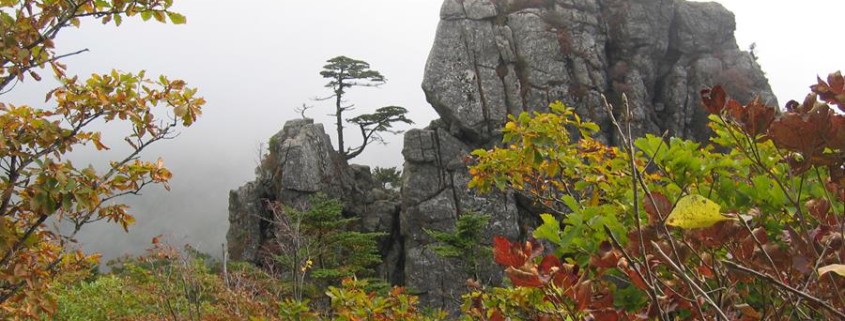Hiking Korea: Mt. Pyeongnae
After a long night of partying in Seoul, I woke up at the crack of dawn (12:30pm) to the sound of incessant ringing. It was Daniel and Phil: turns out, it was a beautiful day, and they wanted to hike. Instead of sitting in bed massaging my throbbing head, I decided to get out of my apartment and give it a shot. I have been in Korea for 3 months, and that’s been more than enough time to discover that Koreans love hiking. It is impossible to miss the hordes of middle aged men, decked out in the latest hiking gear from head to foot, backpack and ski pole walking stick in tow, returning from a day of hiking on the metro. But I’m from the glorious, mountain-rich Pacific Northwest and I get a bit snobby when it comes to hiking, skiing, and mountains. I spent the last 4 years going to college in the Northeast United States making fun of their mountains. While the Northeast has a few nice mountains that provide some decent skiing, I think they are better classified as hills when compared to the Western United States’. So after moving to Korea, it didn’t take me long to start turning my nose up at the Korean mountains. But I looked out my window; indeed it was a beautiful day. I decided to put my prejudice aside and join them: a little fresh air goes a long way in vanquishing a hangover. Worst case scenario, I vomit on the trail.
The trailhead to Mt. Pyeongnae was literally five minutes from my doorstep. This is, in and of itself, representative of how accessible hiking in Korea is. Turns out all of the hikers we’ve seen on and around the mountains are actually going directly to mountains. It’s one of many staggering contrasts between Korea and the Pacific Northwest. In the Northwest, I have to take a 3 hour car trip from Seattle to get to the good mountains (and make sure the four-wheel drive is working to handle the poorly maintained gravel roads near the trailhead). There are a few trails much closer to Seattle, but the point still stands: taking the metro to the mountains is amazingly convenient and unique.
As the trail wound its way up the mountain it switched between mud and ice as it moved in and out of the sun. I didn’t expect an actual steep hiking trail — I guess my Northwest mountain hubris got the better of me. But I managed to make it to the peak without falling into the mud even though at one point we chose the steeper path when the trail forked. While pulling ourselves up the last part with a rope tied to a tree, a Korean couple walked past us using walking sticks and wearing crampons. They fired off a few rapid-fire Korean sentences, which were incomprehensible, but I assumed by their pointing that they were advising us to use the other path on the way down. Looking down at my worn sneakers, I wholeheartedly agreed.
Rope-assent successfully completed, we continued up the ice and mud path to the summit. As we walked we constantly passed small groups of Korean hikers. Every last one of them was decked out, from head to foot, in hundreds of dollars worth of hiking equipment. In my experience, a hiking outfit means basketball shorts, an old t-shirt, and a baseball cap. But apparently in Korea looking the part is just as important as the hiking itself. As countless Koreans walked passed us in their hiking uniforms I couldn’t help but think how silly we must have looked in our outfits. Daniel was wearing a hoodie and shin length cotton shorts (but at least he had real hiking boots). I looked the worst, wearing jeans, a hoodie, and old tennis shoes. And Phil was wearing what would be considered a hiking outfit in the States: pants / zip off shorts and an athletic t-shirt. But it was Phil’s footwear that really caught the Korean’s eyes. The Koreans, clearly into the latest hiking gear, could not get enough of Phil’s toe hiking shoes. Multiple groups of Koreans stopped and ooed and ahhed as Phil wiggled his toes in the air.
After about two or three kilometers, we reached the summit of Mt. Pyeongnae. A two-story gazebo stood at the top of the mountain, rewarding victorious hikers a 360 degree view of the beautiful Korean countryside. The view included several nearby“peaks,” Pyeongnae-dong, my humble home, and the neighboring administrative districts of Namyangju. Standing on a man-made structure gazing out over towns that were built within the last decade isn’t exactly what I’m used to when I go hiking. While it was nice to walk through the trees and briefly escape the city, I never really felt like I was fully out in nature; I could always see something manmade. I got the feeling that the Koreans don’t really mind this: I saw one Korean man charging up the mountain, headphones in, phone out, watching TV. A baffling sight for a nature enthusiast, but as my high school French teacher used to tell us: Ce n’est pas bizarre, c’est different.
In addition to seeing civilization, civilization was brought to us in another form: vendors. Phil told me as we neared the summit: “If there isn’t a shop on the trail then you’re probably not on a trail.” And lo and behold there was a vendor at the base of the gazebo structure offering us a cold bowl of makgeolli for 1000 won. Ce n’est pas bizarre, c’est different. Without a moment’s pause we jumped on the offer. Who cares if we had been drinking the entire night before? It’s a cultural experience! So we each grabbed a bowl and headed up to the second floor of the wooden gazebo. But we were not left in peace to enjoy the view. It turns out three young white guys at the top of a relatively obscure mountain in Korea pass as rock stars. Beore we even sat down, a group Korean men (who turned out to be ex Korean Black Berets) were taking pictures of us. One of them crossed over and posed for a picture with us. When we were finished with our first bowl of makgeolli they brought us refills and gave us Korean hiking snacks (that complimented makgeolli very well). It didn’t take long for them to get comfortable and treat us like one of the guys. After a few minutes of talking (and a few bowls of makgeolli) we were the objects of jokes involving nipple pinching. Next, one guy started gyrating his hips and using the makgeolli bottle as a prop (I’ll let you use your imagination for where he held it). We had transformed the top of the mountain into our personal bar! But when a woman walked up and sat on the bench beside us the men immediately shaped up. Pretty soon the woman started asking us questions too, although she didn’t follow them with sexual jokes. Instead she offered us some coffee — I think she was worried about us making it back down the mountain. After about an hour of basking in pseudo-fame, we took one more look around and headed back down the trail for Pyeongnae.
Heading into the day with an open mind and no expectations, I was more than happy with Korean hiking. Nothing was what I expected. The trails were steeper; the summit was more built up than any peak I have summited; makgeolli was sold at the top; and although different from the majestic mountains of the North Cascades, the views were breathtaking in their own right. It was one of the most unique days of hiking I have ever had and I look forward to seeing what other hikes Korea has to offer. The season is just starting, after all.
Nick Hamilton
- How to get there: Pyeongnae Mountain is one of a couple of trails in Pyeongnae-Dong. The best way to get there is by the new Gyeongchun line to Pyeongnae-Hopyeong Station.
- Cost: The subway ticket should be less than 2,000 won. You might want to wear some proper hiking gear though.
…brought to you by the Adventure Teaching Korea team…
- Teaching English in Nowon-gu of Seoul - August 23, 2022
- Teaching English in Cheongju at Chungbuk International Education Center - August 22, 2022
- Teaching English in Gyeongbuk Province English Camps - August 18, 2022




Leave a Reply
Want to join the discussion?Feel free to contribute!